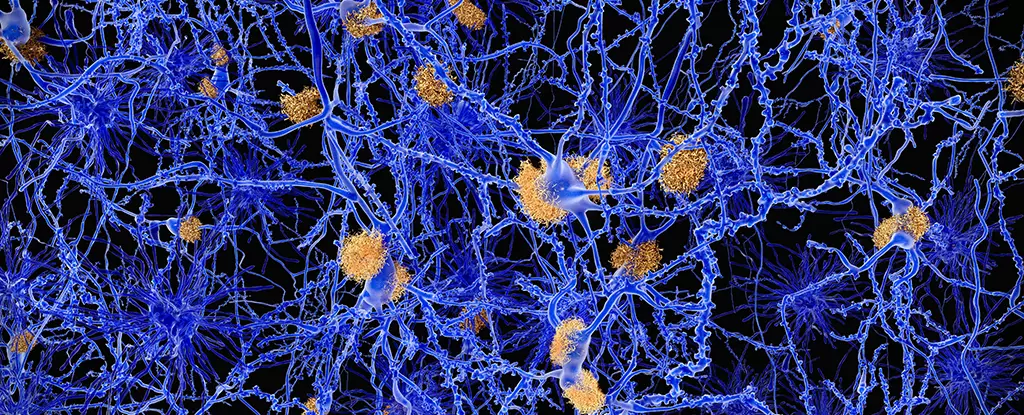Alzheimer’s disease has long been an insidious specter, casting a shadow over millions of lives worldwide. As we grapple with an aging population and the accompanying surge in neurodegenerative disorders, the urgency for innovative solutions cannot be overstated. A recent breakthrough involving nanomaterials offers a beacon of hope in the darkest depths of Alzheimer’s disease, overturning conventional approaches to treatment and challenging our understanding of protein behavior.
The Insidious Nature of Protein Misfolding
At the heart of many neurodegenerative diseases, including Alzheimer’s, lies the disturbing phenomenon of protein misfolding. Proteins, the workhorses of cellular function, can turn against the very neurons they are meant to protect, forming toxic plaques that lead to cellular death. Samuel Stupp, a materials scientist at Northwestern University, emphasizes the catastrophic consequences of misfolded proteins, stating that they can create “destructive fibers that enter neurons and are highly toxic.” This aligns with a growing concern in the medical community: something has gone fundamentally wrong in our ability to maintain protein integrity.
The traditional medical paradigm has largely focused on symptomatic relief rather than addressing the root cause of these diseases. However, the emergence of a cutting-edge treatment involving specially designed nanomaterials is nothing short of revolutionary. Instead of merely treating symptoms, this approach aims to disrupt the very initiation of toxicity by targeting early-stage misfolding of proteins before they can aggregate into harmful plaques.
Innovative Design Meets Biology
The novel treatment utilizes a combination of peptide amphiphiles—molecules that possess both hydrophilic and hydrophobic properties—and trehalose, a natural sugar known for its stabilizing effects on proteins. By leveraging these two components, researchers have demonstrated an unprecedented ability to ensnare misfolded amyloid beta proteins.
Zijun Gao, an organic chemist involved in the research, explains that trehalose plays a pivotal role in making the molecular structure of peptide amphiphiles less stable, effectively facilitating interactions with problematic amyloid beta proteins. The result is a chemical cage that inhibits the formation of toxic aggregates, acting as a “clean-up crew” for misfolded proteins. This proactive methodology stands in stark contrast to previous attempts that focused on managing symptoms after the fact—a far too passive approach for a disease that relentlessly strips away cognition and identity.
Ethical Considerations and Future Implications
Despite this groundbreaking research, we must proceed with caution. The ethical ramifications of engineering nanomaterials for human use cannot be ignored. Are we prepared to fully understand the long-term effects these substances might have on the human body? While the promise is significant, the research is still in its infancy, and extensive studies will be needed to gauge safety and effectiveness in human subjects.
Moreover, as we celebrate scientific advancements, we must confront a stark reality: the global burden of Alzheimer’s disease is escalating. With an estimated 10 million new dementia diagnoses each year, the imperative for swift and effective treatments has never been more critical. The challenges posed by an aging population necessitate a multifaceted approach to healthcare, marrying innovation with ethical responsibility.
In the opening stages of exploration, the potential of this new treatment is exhilarating, but it is essential that we temper our expectations with realism. The frustrations of patients and families affected by Alzheimer’s highlight the urgency, but we must remember that the journey from laboratory success to widespread clinical application is fraught with challenges.
A Call for Continued Innovation
In light of these advancements, it is evident that the future of neurodegenerative disease treatment must pivot towards a more proactive strategy. By utilizing molecularly engineered nanomaterials, we are not simply hoping for a breakthrough; we are actively participating in the revolution. This approach may represent not just a treatment— but perhaps a paradigm shift in how we view and address Alzheimer’s disease and its ilk.
As research progresses, the world may find itself on the precipice of monumental change. The scientific community’s vigilant pursuit of this promising avenue could yield a legacy of solutions that not only treat but prevent the devastating impacts of Alzheimer’s, ultimately restoring dignity to countless lives affected by this wretched disease. Let’s continue to champion innovative thinking and ethical science; the battle against Alzheimer’s is far from over.


Leave a Reply